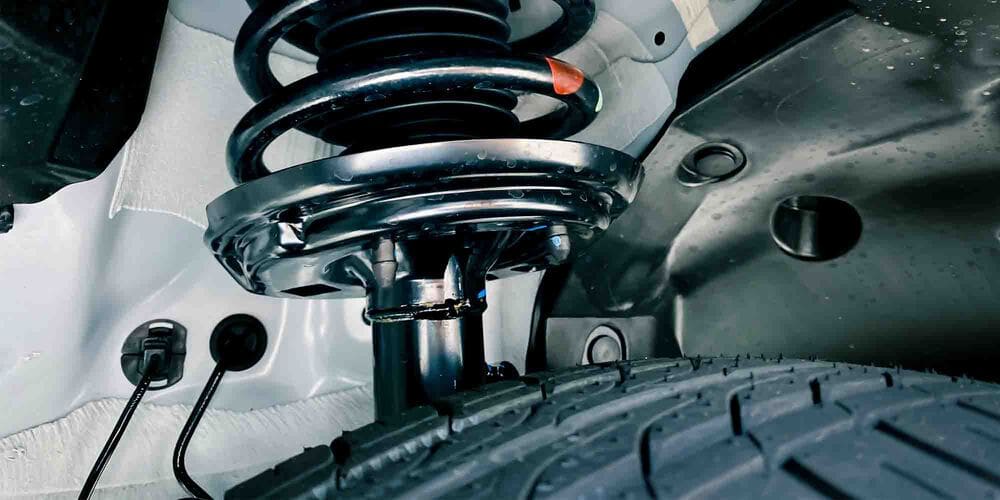
Shocks and struts are an essential part of a vehicle’s ability to operate smoothly and safely. However, these components do become worn over time and can sustain damage. That’s why shock and strut maintenance should be a part of your regular vehicle maintenance routine. Read on for more on the importance of keeping your shocks and struts in good condition.
WHAT ARE SHOCKS?
Shock absorbers are the hydraulic components in a vehicle that minimize movement generated by springs. They absorb some of the jolts caused by bumps and unevenness in the road. Decreasing the impact of rocky terrain and rough roads can help the driver maintain control of the vehicle. Shocks ensure a smoother, safer driving experience.
WHAT ARE STRUTS?
A vehicle’s struts are structural components of its steering and suspension systems. They are made of a spring and a shock absorber. They are designed to be stronger than shocks due to the fact that they are weight-bearing components. They also help dampen the car’s joints to improve alignment and steering.
WHAT HAPPENS IF THEY FAIL?
There are a number of negative effects that worn out or damaged shocks and struts can have on your vehicle. It is important to include having your struts and shocks examined as part of your regular maintenance routine. The following are vehicle issues commonly caused by shock and strut failure:
WEAR AND TEAR ON TIRES
Issues with shocks and struts can put extra pressure on a car’s tires that should be handled by the suspension. Uneven tread pattern on tires is often a sign of bad shocks and/or struts and is definitely a sign that you should have a mechanic take a look. You can check for uneven wear by examining your tire. Even brand-new tires can be damaged by bad shocks or struts, so it is critical to have them replaced immediately in order to keep your tires in good condition.
LESS CONTROL OVER STEERING
Shocks and struts grab the road while you’re driving, which becomes more difficult when they’re worn out. It becomes even more difficult when navigating curves or corners or when driving on uneven pavement. If you’re having suspension issues, your car may start to sway and become less responsive when you turn the steering wheel. It may also feel like it is being pulled in the other direction when you try to turn. More force is then needed to turn the wheel, which then places undue pressure on your power steering components, meaning they will wear out even faster. If you notice issues with steering, shocks and struts may be the culprit, and you should have a mechanic take a look.
INCREASED ACCIDENT RISK
Because the suspension system is an integral part of the car’s ability to operate safely, issues with shocks and struts can easily lead to an accident. Reduced braking ability, poor performance taking turns and corners, prematurely worn tires, and loss of control driving on rough terrain or speed bumps can easily give way to an accident. Bad struts and shocks can cause damage to other parts of your vehicle over time, making it even more unsafe to drive. It is important for public safety to make sure your suspension system is firing on all cylinders. If you notice anything out of the ordinary, contact your local mechanic immediately.
SIGNS OF SHOCK AND STRUT FAILURE
Leaking Fluid
If you notice fluid of any kind leaking from your vehicle, it’s probably a sign that something isn’t right. One cause of leaking fluid is strut or shock damage, which occurs when the upper seals become damaged or worn. This can be caused by dirt and debris getting inside the shock and/or strut. Shocks and struts need hydraulic fluid to absorb the force of the road. Without it, the car can roll more easily.
Decreased Braking Ability
One of the primary purposes of shocks is to absorb the force of the car against the road. This is especially important when the car is braking. Brakes put force on the wheels to stop them; the suspension system directs that force to the rest of the vehicle. Poorly functioning shocks have a majorly reduced ability to absorb the force of a vehicle coming to a stop. A study conducted by the Royal Automotive Club found that vehicles driving on 50% worn-out shocks took an average of 11% longer to stop. At highway speeds, this is equivalent to up to two car lengths, which can easily result in a collision. The ability to stop quickly and efficiently is crucial for the safety of vehicle occupants and other motorists on the road.
Issues with Turning and Acceleration
Rear-wheel drive cars generate a large amount of torque when the car starts to accelerate. When its suspension is functioning properly, it absorbs the torque and redistributes it to the front wheels. This enables the car to accelerate evenly. If shocks start to go bad, the car loses the ability to distribute that force throughout the car and rear wheels are left handling most of it. This uneven torque distribution can cause the wheels to lose contact with the road, which is known as “acceleration squat.” Obviously, this is a very dangerous situation, so keeping your shocks in good shape is critical.
Loss of Control Over Bumps and Rough Terrain
Faulty shocks and struts can cause issues with navigating across dips, bumps, and other uneven terrain. They can cause your wheels to start to bounce or vibrate, which can compromise your ability to control the vehicle. It may feel like your vehicle is not making contact with the road in these situations. An unusually shaky or bumpy ride often means suspension problems. This can increase the chance of hydroplaning in the rain, so it’s important to address the issue as soon as possible.
Courtesy of hollenshades










